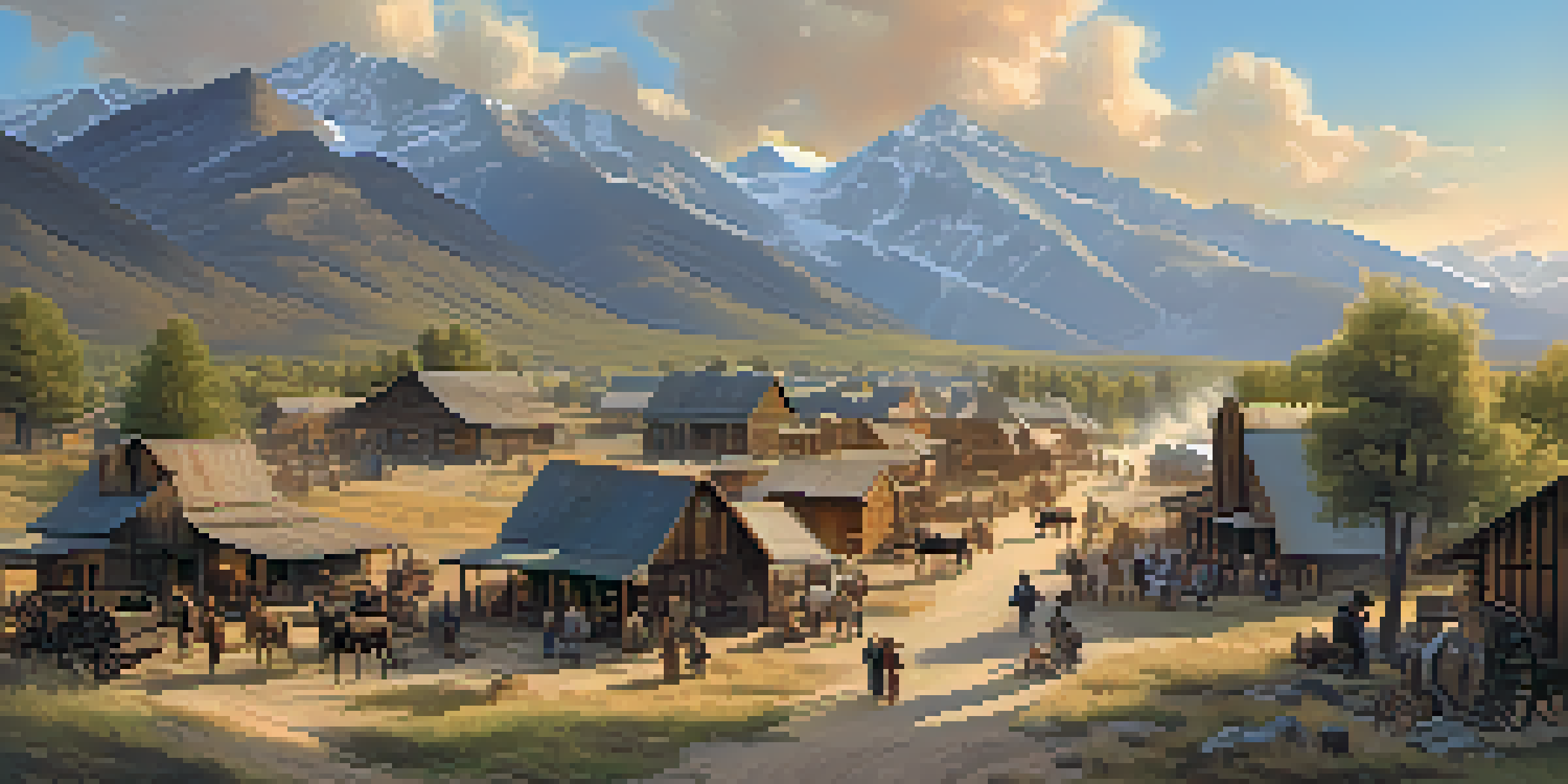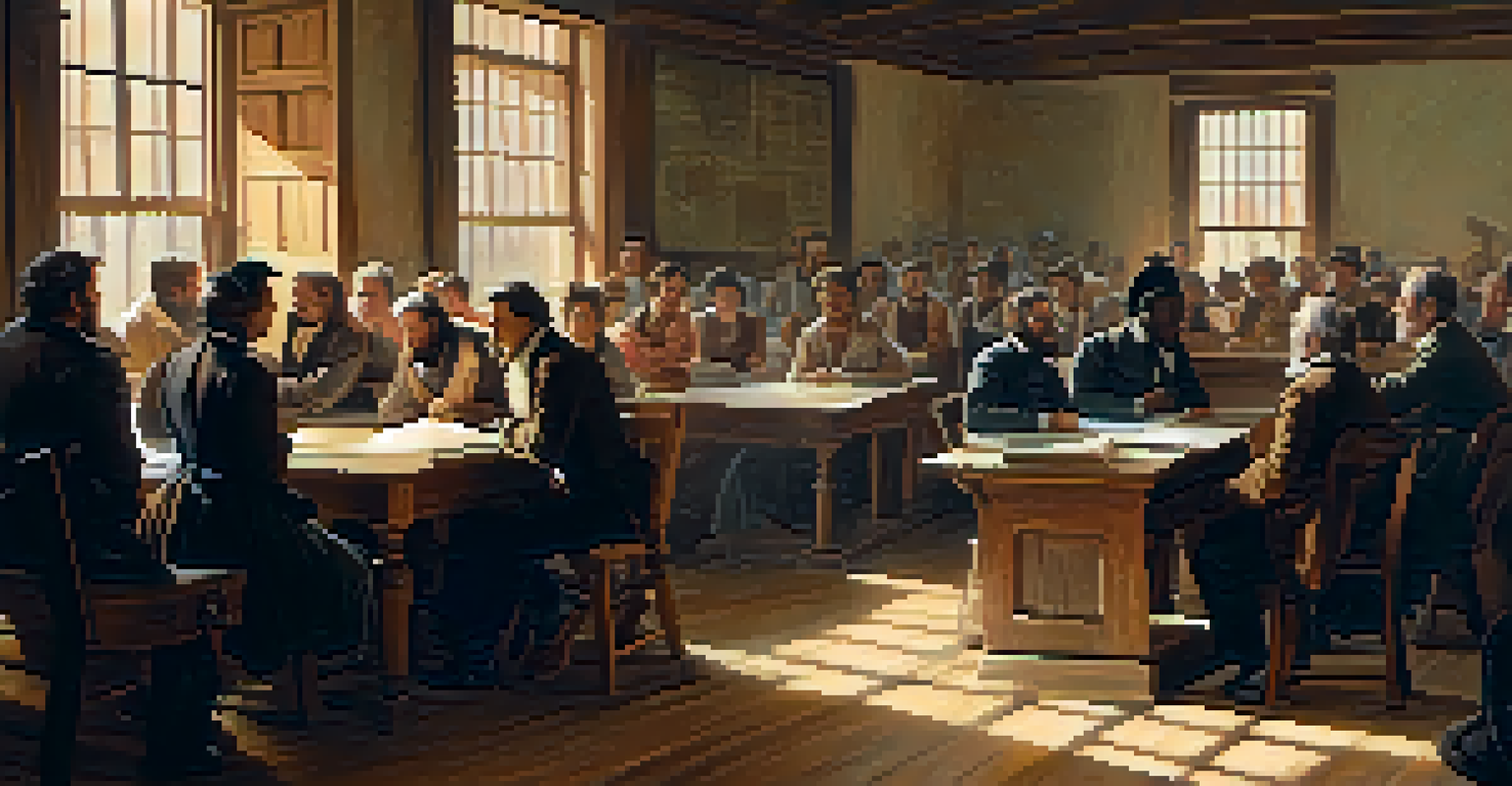The Compromise of 1850 and Its Impact on Colorado Territory

Understanding the Compromise of 1850
The Compromise of 1850 was a pivotal set of legislative measures aimed at easing tensions between slave and free states in the United States. It came about during a time when the nation was deeply divided over the issue of slavery, particularly as new territories were being formed. This compromise included several key provisions, such as admitting California as a free state and introducing the Fugitive Slave Act, which compelled citizens to assist in the capture of runaway slaves. Ultimately, this agreement sought to maintain a fragile peace between the North and South, but it also laid the groundwork for future conflicts.
Compromise is the art of dividing a cake in such a way that everyone believes he has the biggest piece.
While it may seem distant to us today, the Compromise had immediate repercussions for territories like Colorado. Though Colorado was not yet a state at the time, it was part of the larger debate surrounding westward expansion and the spread of slavery. As settlers moved westward, the question of whether new territories would be free or slave states became increasingly contentious, leading to significant political and social challenges.
The ramifications of the Compromise were felt not only in the political arena but also in the everyday lives of those living in or moving to Colorado. Individuals flocked to the new territory, drawn by the promise of land and opportunity, while carrying with them the social attitudes and beliefs of their home states. Consequently, Colorado became a melting pot of ideas, some aligning with the abolitionist movement and others staunchly defending slavery.
The Role of Colorado in the National Debate
As the West opened up, newly established territories like Colorado became focal points in the ongoing national debate over slavery. The territory's location and resources made it strategically important, and many settlers had strong opinions about whether it should be free or slave. This debate was not just academic; it impacted the daily lives of the inhabitants, influencing everything from local governance to land ownership.

In the years following the Compromise, Colorado saw an influx of settlers driven by the Gold Rush and the allure of economic opportunity. Many of these newcomers brought their beliefs about slavery with them, adding to the already complex social landscape. This influx sometimes led to heated debates and even violence, as different factions tried to assert their vision for the territory's future.
Compromise Affected Colorado's Identity
The Compromise of 1850 intensified social tensions in Colorado, as settlers arrived with conflicting views on slavery, shaping community interactions and territorial governance.
The growing population and the escalating tensions set the stage for Colorado to become a microcosm of the national conflict. As settlers established communities, they had to grapple with the realities of slavery, labor, and human rights, often leading to a patchwork of laws and social norms that reflected the varied beliefs of a diverse population.
How the Compromise Affected Colorado's Governance
The governance of Colorado Territory was significantly influenced by the political machinations stemming from the Compromise of 1850. The newly formed territorial government had to navigate the complexities of both local desires and national policies, leading to a unique set of laws and regulations. As a result, the political landscape was marked by constant maneuvering to align with or resist the prevailing attitudes toward slavery.
History is not a burden on the memory but an illumination of the soul.
Territorial leaders often found themselves caught between the expectations of their constituents and the overarching pressures from the federal government. This tug-of-war sometimes resulted in conflicting legislation, creating confusion among settlers and undermining the stability of the region. As laws were enacted and repealed, the citizens of Colorado had to adapt to an ever-changing political environment.
Moreover, the governance issues tied to the Compromise laid the groundwork for future conflicts over statehood. As the territory progressed toward becoming a state, the unresolved questions surrounding slavery and governance would continue to influence its political identity and social fabric.
Social Tensions in Colorado: Free vs. Slave State
The Compromise of 1850 exacerbated social tensions within Colorado as settlers arrived with differing views on slavery. Some groups were staunchly opposed to the institution, advocating for Colorado to become a free state, while others sought to establish it as a haven for slaveholding. This division created an atmosphere of discord and hostility, shaping community interactions and relationships.
Local debates often spilled into violence, with factions clashing over their beliefs regarding slavery. For instance, pro-slavery settlers would sometimes confront abolitionist groups, leading to skirmishes that underscored the intensity of these ideological divides. Such conflicts not only affected the settlers' day-to-day lives but also influenced the territorial government's ability to maintain order and enact effective legislation.
Economic Debates on Labor Practices
The economic implications of the Compromise led to significant debates in Colorado about the role of slave versus free labor in shaping the territory's future.
This social friction had long-lasting effects on Colorado's identity, as the territory struggled to define itself amid the national crisis. The legacy of these tensions would extend beyond the Civil War, impacting political affiliations and social dynamics for generations to come.
Economic Opportunities and Slave Labor
The Compromise of 1850 brought not only social and political challenges but also economic implications for Colorado. As the territory developed, the question of labor—specifically, the status of slave labor—loomed large. Some settlers believed that slave labor could enhance agricultural production and resource extraction, while others argued that free labor was more beneficial for a burgeoning economy.
This economic debate highlighted the differing visions for Colorado's future. Supporters of slavery argued that it would bring wealth and stability, while abolitionists contended that a free labor system would foster innovation and create a more just society. Ultimately, these contrasting perspectives fueled tensions and divided communities as they sought to carve out their economic futures.
As the Gold Rush attracted a diverse population, the economic landscape of Colorado continued to evolve. While slavery was never as entrenched in Colorado as in other regions, the conversation about labor practices and economic models persisted, shaping the territory's development and identity.
The Road to Statehood: Legacy of the Compromise
The legacy of the Compromise of 1850 played a critical role in Colorado's journey toward statehood. As the territory matured and its population grew, the unresolved issues surrounding slavery continued to influence discussions about statehood. The question of whether Colorado would enter the Union as a free or slave state became a point of contention among political leaders and settlers alike.
In the years leading up to statehood, the political landscape was marked by intense debates and negotiations. The memory of the Compromise loomed large, reminding leaders of the challenges of balancing diverse interests and the need for unity. Ultimately, Colorado was admitted as a free state in 1876, but the path to that decision was fraught with tension and conflict.
Path to Statehood Influenced by Conflict
The unresolved issues from the Compromise of 1850 continued to influence discussions about Colorado's statehood, ultimately leading to its admission as a free state in 1876.
This journey reflects how the Compromise of 1850 set in motion a series of events that shaped not only Colorado's political identity but also its social and economic structures. The unresolved issues from the Compromise would echo through Colorado's history, influencing its development long after it became a state.
Reflection on the Compromise's Impact Today
Reflecting on the Compromise of 1850 and its impact on Colorado Territory invites us to consider the complexities of our nation's history. The debates and conflicts that arose during this time laid the groundwork for the social, political, and economic fabric of Colorado as we know it today. Understanding this historical context helps us appreciate the challenges and triumphs of the state's development.
Today, Colorado is often celebrated for its diversity and progressive values, but these characteristics emerged from a tumultuous past shaped by the tensions surrounding slavery. The conversations and conflicts that began with the Compromise continue to resonate in modern discussions about race, labor, and social justice. Acknowledging this legacy is essential for understanding the ongoing struggles for equality and justice in our society.

Ultimately, the Compromise of 1850 serves as a reminder of the importance of dialogue and compromise in addressing contentious issues. As we navigate contemporary challenges, the lessons learned from this historical moment can guide us toward a more inclusive and equitable future for all.